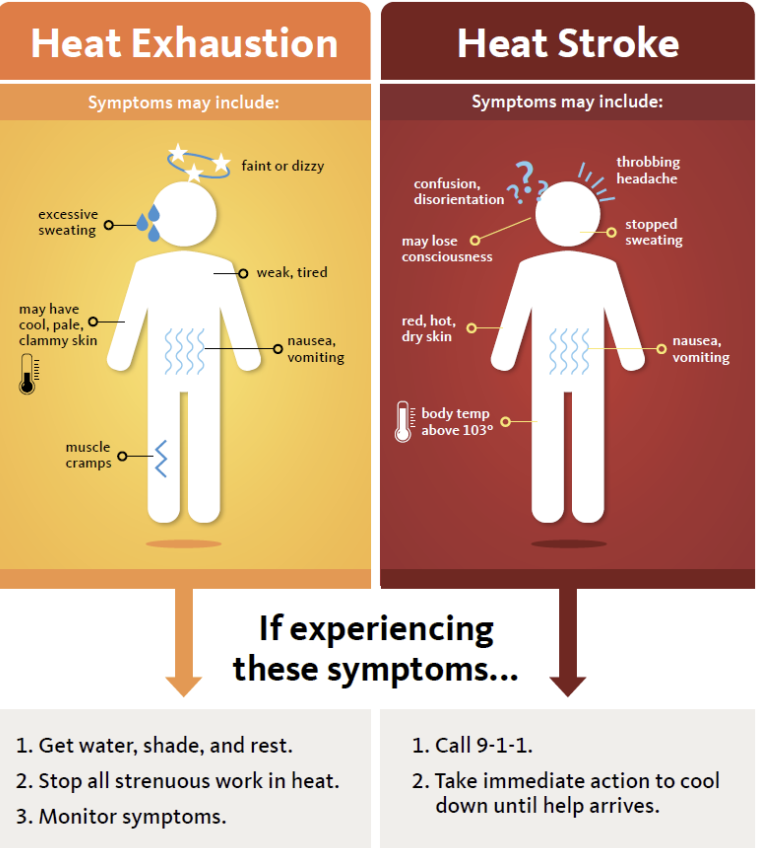From the Emergency Department: Heat Awareness
.jpg?ixlib=rb-1.1.0&w=2000&h=2000&fit=max&or=0&s=2146b18103e92927192a810cd0288e4d)
With summer in full swing, the risk of heat-related illnesses—particularly heat exhaustion and heat stroke—increase significantly. Understanding the difference between the two, and how to respond, is essential for staying safe. Whether you're heading into the high country for a short hike or a full-day adventure or enjoying a long festival weekend, preparation is key. Staying hydrated, wearing appropriate clothing, and knowing the signs of heat-related illness can help you avoid an unexpected trip to the ER. The average person should be consuming ¾ of a gallon of water daily and if you are sweating a lot, combine your water intake with a sports drink and/or a snack to help replace the salt and minerals you lose in sweat.
Heat exhaustion is often a warning sign and can progress into heat stroke, a serious medical emergency, if not treated promptly. Heat stroke creates neurological changes that if left untreated can result in permanent damage, if not death. Individuals of any age can experience heat exhaustion / heat stroke, with infants, children, the elderly and pregnant women at higher risk. It’s particularly important for responsible adults to take preventative measures and watch for signs of heat illness in infants and children, as they aren’t able to express symptoms early on.
If someone shows signs of heat exhaustion or heat stroke (see image below), the first step is to move them to a cool, shaded, or indoor location. Apply cold, damp towels to their skin and encourage them to drink fluids. If symptoms of heat stroke—such as confusion, loss of consciousness, or a high body temperature—are present, take immediate action to cool the person, and then call 911 or take them immediately to the nearest emergency department.
Happy Adventuring! We hope we do not have to see you, however if you need us we are always here!

TOMA DE CONCIENCIA SOBRE CALOR
Con el verano en pleno apogeo, el riesgo de enfermedades relacionadas con el calor, en particular el agotamiento por acaloramiento y la insolación, aumenta significativamente. Comprender la diferencia entre los dos y cómo tratarlos es esencial para mantenerse a salvo. Ya sea que vaya a la montaña para una caminata corta, una aventura de un día completo o disfrute de un festival largo un fin de semana, la preparación es clave. Mantenerse hidratado, usar ropa adecuada y conocer los signos de enfermedades relacionadas con el acaloramiento puede ayudarlo a evitar un viaje inesperado a la sala de emergencias. Una persona debe consumir 3/4 de galón de agua al día y, si suda mucho, combine su ingesta de agua con una bebida deportiva y/o un refrigerio para ayudar a reemplazar la sal y los minerales que pierde con el sudor.
El agotamiento por acaloramiento suele ser una señal de advertencia y puede convertirse en un golpe de calor, una emergencia médica grave, si no se trata con prontitud. El golpe de calor crea cambios neurológicos que, si no se tratan, pueden provocar daños permanentes, y hasta la muerte. Las personas de cualquier edad pueden experimentar agotamiento por calor o insolación, y los bebés, los niños, los ancianos y las mujeres embarazadas corren mayor riesgo. Es particularmente importante que los adultos tomen medidas preventivas y estén atentos a los signos de enfermedades causadas por el calor en bebés y niños, ya que ellos no pueden expresar los síntomas desde el principio.
Si alguien muestra signos de agotamiento por acaloramiento o insolación (vea la imagen a continuación), el primer paso es trasladarlo a un lugar fresco, sombreado o adentro. Aplique toallas frías y húmedas sobre la piel y anímelo a beber líquidos. Si se presentan síntomas de insolación como confusión, pérdida del conocimiento o temperatura corporal alta, tome medidas inmediatas para calmar a la persona y luego llame al 911 o llévela de inmediato a la sala de emergencias más cercana.
¡Que disfrute de sus aventuras! Esperamos no tener que verle, pero, si nos necesita, ¡siempre estamos aquí!
